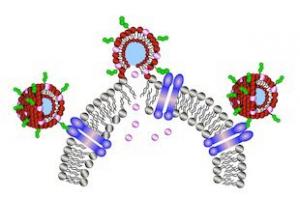SD Nanosciences Develops Technology for Creating Targeted Drug and Vaccine Delivery Vehicles
Sunday, January 25, 2015
- MedImmune, AstraZeneca’s global biologics R&D arm, provides $1 million to researchers at UM Ventures start-up to further test and evaluate the technology for vaccine delivery -
College Park, Maryland, January 25, 2015 – When University of Maryland, College Park (UMCP) Professors Philip DeShong and Daniel Stein began tagging soap bubbles with biomolecules, they had no idea this technology, exclusively licensed from UMCP, would one day be poised to change the way drugs and vaccines fight against bacteria, viruses and cancer.[1]
DeShong, a professor of chemistry and biochemistry, and Stein, a professor of cell biology and molecular genetics, founded the College Park-based start-up company, SD Nanosciences, in 2007 to commercialize their drug and vaccine delivery technology, which is the basis for four pending patents.
Today, the researchers are covering soap bubbles with biomaterials that act as a disguise, tricking the body’s cells into mistaking the capsule for a bacterium, a cancer cell or almost any other disease-causing cell. Because the technology is flexible, cost effective and highly efficient, it is drawing a lot of attention from both public and private funders for drug delivery and vaccine production.
In May 2014, the researchers received $1 million from MedImmune, the global biologics research and development arm of AstraZeneca, to further test and evaluate their technology for vaccine delivery. MedImmune and the University of Maryland System entered into a research collaboration a few years ago. This is one of several regional collaborations MedImmune has with leading research institutions and the state to advance Maryland as a top biotechnology cluster, advance innovative science and accelerate development of key medicines for patients.
“MedImmune is supporting development of the technology through preclinical studies that will test the vesicle’s efficacy, stability and safety as a vaccine platform,” said DeShong, who is also president of SD Nanosciences. “This research will help us answer questions such as: How general is the technology for creating vaccines? How well does it work to create a desired vaccine? Can you use it to create different types of vaccines?”
For drug delivery applications, the disguised vesicle is filled with medication—a cancer drug, for example—and decorated on the outside with a targeting agent that is recognized selectively by cancer cells. As a result, the vesicle attaches preferentially to cancer cells and releases the drug. Because the functionalized vesicles bind preferentially to cancer cells rather than normal cells, the researchers anticipate this delivery method will result in lower effective doses for the drug and reduced side effects.
In October 2014, the two professors received a Maryland Innovation Initiative (MII) award of $150,000 from TEDCO to continue their work developing vaccines against Gram-negative bacteria.
DeShong and Stein are also working with researchers at the University of Maryland School of Medicine to test the efficacy of functionalized catanionic surfactant vesicles to deliver a cancer drug. Cross campus research like this is one of the goals of UM Ventures, which brings the University of Maryland, Baltimore and UMCP together to commercialize discoveries, and create economic impact by engaging partners in industry and social ventures. By encouraging students and faculty, providing expert advice and business services, more discoveries will reach the market.
Sangeetha Raghavan, life science licensing associate in UMCP’s Office of Technology Commercialization (OTC), said that the simplicity, robustness and low-cost nature of the technology made it licensable and very appealing to the biotech industry. “It sounds so simple—you can apply this technology to any pathogen out there that has an antigen and produce a vaccine in 72 hours,” she said.
The researchers have received additional funding for this work from the National Institutes of Health, National Science Foundation, DuPont and the Maryland Industrial Partnerships program.
“In principle, there are thousands of viruses we could make vaccine against, there are thousands of bacterial infections we could make vaccines against, and there are thousands of drugs we could deliver in a targeted way into the body,” said DeShong. “We’ve created a flexible platform with these decorated soap bubbles that should be able to make them all of them.”
[1] This story is adapted from an article written by Abby Robinson, Media Relations, University of Maryland, College Park
